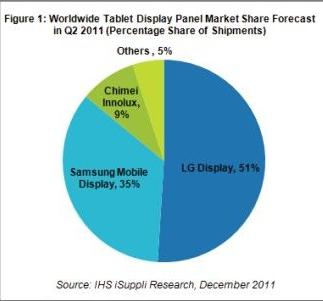 According to IHS, what do Apple iPad, Amazon Kindle Fire and Barnes & Nook all have in common? According to IHS iSuppli’s small and medium monitor market tracking reports, these products all use Korean LG displays as the main source of their display panels – which makes LG displays the number one supplier of media flat panel displays.
According to IHS, what do Apple iPad, Amazon Kindle Fire and Barnes & Nook all have in common? According to IHS iSuppli’s small and medium monitor market tracking reports, these products all use Korean LG displays as the main source of their display panels – which makes LG displays the number one supplier of media flat panel displays. Although Apple, Amazon, and Barnes & Noble’s flat products are quite different, LG Display has used IPS technology in its small and medium-sized LCD panels, which has become the object of the three tablet PC makers. Small and medium-sized display panels range in size from 7 to 10 inches and are also used in smart phones, digital cameras and MP3 players.
LG Display is far ahead in the Tablet PC display market, with a market share of 51% in the second quarter. The share of South Korea’s Samsung mobile display company, which is ranked second, is only 35%. Samsung Mobile Display also provides panels for the Apple iPad and also supplies the Samsung Galaxy Tab. Taiwan's Chi Mei Electronics ranked third, the company is also an Apple supplier, but also to the Chinese white card market, its share is 9%, as shown in Figure 1. The remaining 5% of the tablet display market is divided by several smaller vendors.
Since Apple introduced the iPad last year, the tablet has become one of the main drivers driving the growth of the small and medium-sized display market. Tablet PC shipment growth this year is expected to reach a staggering 462%. In addition, at a time when sales of many consumer electronics products are sluggish, the composite annual growth rate of tablet PCs in 2011-2015 will still reach 38%, highlighting its good prospects.
LG Display is able to dominate the market for flat panel displays thanks to its IPS-enabled active-matrix amorphous-silicon LCD panels with faster response, wide viewing angles up to 179 degrees and no smearing, and power consumption It is reduced by 30%. Another wide viewing angle technology similar to IPS is the Fringe Field Sequential (FFS) LCD. The patent for FFS LCD is in the hands of Taiwan's LCD supplier E Ink (Hydis). However, due to E Ink's lack of ability to manufacture large-size panels, E Ink licensed the technology to liquid crystal suppliers such as LG Displays and several other suppliers. LG Display also has a competitive advantage in this regard. It offers more production capacity for media tablets than other manufacturers.
Do not hesitate to invest a lot of production capacity, combined with Apple's major suppliers, which makes LG Electronics in a favorable position in the market. As demand continues to increase, tablet PCs currently enjoy a premium over conventional TN LCDs. Currently, the 9.7-inch tablet IPS monitor costs about $60, and the 7-inch tablet IPS monitor costs about $50.
Higher specification requirements, but even limited competition will get hotter. For manufacturers who want to enter the flat panel display market, many obstacles must be overcome. Among them, in order to get the favor of the best-selling tablets, these devices must meet the higher pixel format requirements and display size specifications.
9. The x-inch is the size of the iPad and is also the industry's major size, accounting for 63% of the market. 9. The standard pixel format for the x-inch display is QHD, which is 1,024 x 600 and 170 pixels per inch. The new Kindle Fire and Galaxy Tab use a 7. x inch, with an 18% market share. 7. The standard pixel format for x-inch displays is 1,024 x 768, which is a 132-pixel display per inch. Some have speculated that Apple’s iPad will use a Retina display with a resolution greater than 300 pixels per inch. It is expected that the iPad3 will be launched in 2012. If this is true, this will increase the resolution of the media tablet industry and prompt other tablet manufacturers to follow suit.
IHS believes it will be very difficult to compete in this market if manufacturers fail to meet the above pixel standards, or if they are unable to efficiently produce qualified displays of this size and resolution.
However, IPS technology may soon encounter powerful opponents. Sharp introduced a new type of oxide material, IGZO, containing indium, gallium, and zinc, which produces pixels that are 20 to 30 times faster than amorphous silicon, enabling faster refresh rates. In addition, because the number of transistors is reduced and the light transmittance of each pixel is increased, IGZO displays have higher energy efficiency levels and are more efficient.
IGZO can make use of the existing amorphous silicon production line, with only a slight modification, so it is more competitive in terms of cost than low-temperature polysilicon. This high-end, cost-competitive display will be produced at Sharp's 8th-generation plant and is expected to begin production this year. The factory is located in Kameyama City, Japan.
The upcoming tablet technology battle is about to start, and this upcoming technology may determine which tablet monitor provider will be the most dazzling in the next few years.
The author Vinita Jakhanwal is director of small and medium-sized displays at IHS, and Michael Grey is a small and medium-sized display researcher at IHS.
Roller Blind Mechanism,Roller Blind Geared System,Roller Shade System
Ruixiang M&E Co., Ltd. , http://www.gzcurtainmotor.com
